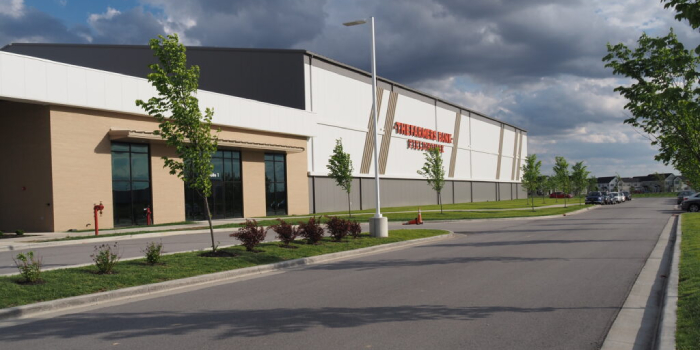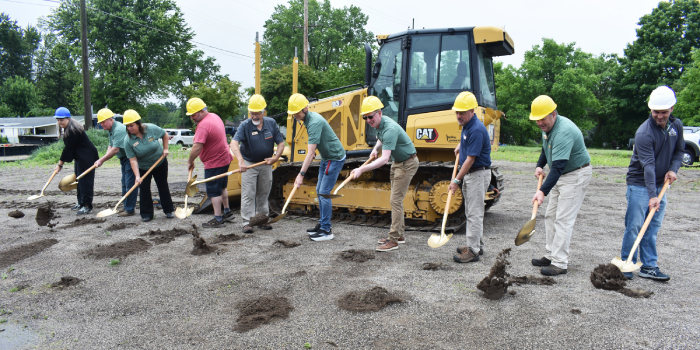Lebanon is the latest in a trend of communities investing in sports facilities. Photo by Niki Kelly, Indiana Capital Chronicle.
LEBANON —
Sports tourism projects have popped up all over the state — from Columbus and Noblesville to Hammond and Newton County.
Mike Edwards, an associate professor at North Carolina State University, who researches sport and community development, said that type of investment can benefit communities, but only if the needs of local residents remain the priority.
On the outskirts of Indianapolis, the $49-million Grand Park Sports Complex, has 15 clover-shaped outdoor baseball fields visible from above, sprawling across acres of open land.
Weekends are the busiest times for the complex, which opened in 2016, as it is usually hosting youth sports tournaments and larger events. Grand Park’s largest events are the
Crossroads of America College soccer showcase
, the
NXT Lacrosse MidAmerica Invitational
and the
Amateur Baseball Championships
. Grand Park also hosts the
Indianapolis Colts Training Camp
. Occasionally, the complex will host non-sporting related events — including farming and equipment expos, corporate events and even a political rally for President Donald Trump
during his inaugural campaign
. Youth sports teams train at the soccer fields and baseball diamonds for the rest of the week.
The Lebanon Leprechauns face off against the Logansport Iron Horses on Saturday, May 23. Photo by Niki Kelly, Indiana Capital Chronicle.
Revenue for Westfield’s Grand Park reached
an all-time high last year
, as reported earlier this year by Inside INdiana Business. Recently, an adjoining sports, entertainment and business district started generating enough tax increment financing to cover debt payments roughly a decade after opening.
The city still owes $62 million, according to the story, with payoff scheduled for 2041. But, unlike other public parks, the complex isn’t free for residents to use — similar to how other publicly funded sports complexes operate.
Access to these facilities and their programs often depends on a family’s ability to travel and keep up with the rising expenses associated with youth sports.
While local leaders see the economic benefits from sports complexes, the multi-million-dollar complexes often shut out children who can’t afford to participate.
For example, open courts at the Lebanon sports complex cost $12 per session, unless you purchase a membership for at least $50 per month. A junior hoops summer camp starts at $250 per child while a volleyball camp is $200.
Beyond infrastructure, these complexes reflect a cultural shift in how some Americans view youth sports — not just as recreation, but as tools for community advertising and development.
Many of these complexes pop up in rural areas where land is more readily available, which can create other participation hurdles for families such as a shortage of volunteers to coach or maintain playing spaces.
Courts at Lebanon’s sports complex can shift to accommodate both tennis and pickleball matches. Photo by Niki Kelly, Indiana Capital Chronicle.
Limited parks staffing and tight municipal budgets can make it difficult to maintain scattered parks and fields. In response, Edwards said, many towns have moved toward consolidation.
Cassandra Coble, an associate professor at Indiana University who researches youth sports, said she worries about the rise of these complexes, many of which are private, and their long-term effect on youth participation as costs for travel, equipment and private coaching increase
The average U.S. family spent $1,016 on their child’s primary sport in 2024, a 46% increase since 2019, according to a recent survey by the
Aspen Institute
. This figure doesn’t include expenses related to secondary or even tertiary sports teams. When added up, parents said they spent around $1,500 dollars in 2024.
In total, families in the U.S. currently spend an estimated $40 billion annually on youth sports — double the revenue generated by the NFL, according to the Aspen Institute study. That figure leaves out additional public spending by schools and municipalities, and investments from private facility operators.
Experts, including Coble, say the growing commercialization of youth sports is limiting access to equitable opportunities and, in some cases, is pricing children out of participation altogether.
Across the state, Fort Wayne’s city leaders introduced plans for a $1.5 billion redevelopment project in February.
The first phase of the proposed North River development includes the North River Fieldhouse, a 160,000 square foot, $60 million facility to advance Fort Wayne’s standing in the sports tourism industry, according to a
news release from the city
.
Kids play at The Farmers Bank Fieldhouse in Lebanon during a Lebanon Leprechauns game on Friday, May 23. Photo by Niki Kelly, Indiana Capital Chronicle.
It’s expected to host events 27 weekends of the 52-week year, create about 900 new jobs and generate an anticipated $36 million in new economic activity, according to
consulting firm Victus Advisors
. The city recently
approved a contract with Victus
to secure a developer for the site.
The city hasn’t yet determined how it will finance such a project, though it is exploring whether it can tap into
federal money slated to help with river cleanup
, according to WANE, a local television station.
The facility will also be available for public use outside of the tournament season.
Alec Johnson, Fort Wayne’s deputy director for redevelopment, said that the facility is expected to serve as a catalyst for the success of the rest of the mixed-use district, which will include a boutique hotel, riverwalk, shopping and dining alongside the proposed soccer stadium, natatorium, E-sports venue, athletic fields and basketball courts.
Niki Kelly contributed to this report.






